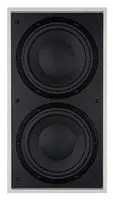Loading ...
Loading ...
Loading ...

10
red) should be connected to the positive output
terminals on the amplifier and the negative terminals
on the subwoofer (marked – and coloured black)
connected to the negative output terminals on the
amplifier. Incorrect connection can result a confused
sound with poor bass.
Switching On and Off
The subwoofer amplifier is best switched on after
any other items are switched off first. The On/Auto/
Standby and Status Indicator operate as follows:
On: With the switch set to “On”, the subwoofer
amplifier will remain fully active and the indicator will
glow green.
Auto: With the switch set to “Auto”, the subwoofer
amplifier will initially become fully active and the indicator
will glow green. After about 5 minutes without an input
signal, the subwoofer amplifier will automatically enter
“sleep” mode. The indicator will glow red. When an
input signal is detected, the subwoofer amplifier will
automatically become active and the indicator will glow
green. The subwoofer amplifier will return to sleep after
about 5 minutes with no input signal.
Audio-visual processors incorporating an “automatic”
set up procedure may be “confused” by a subwoofer
amplifier with an auto switch-on/sleep function. A
potentially damaging fault condition can arise. The
subwoofer amplifier is best left switched on and fully
active during set up if such a processor is used.
Standby: With the switch set to “Standby” the
subwoofer amplifier will become active when it
receives an appropriate trigger signal via its 12V
Trigger Input. Turning off the 12V signal will return the
subwoofer amplifier to sleep. The indicator will glow
green when the subwoofer amplifier is active and red
when the subwoofer amplifier is in sleep.
Setting The Subwoofer Amplifier Controls
There are 6 controls to consider:
The VOLUME (LINE) control.
The LOW-PASS FREQUENCY control.
The LOW-PASS FILTER switch.
The BASS Extension switch.
The EQUALISATION.
The PHASE switch.
The appropriate settings depend on the equipment
used with the subwoofer and the modes of
connection. If using more than one subwoofer
amplifier, ensure the controls on each one are set the
same.
Home Theatre Settings
Set the VOLUME control initially to the 9 o’clock
position.
Set the LOW-PASS FILTER switch to OFF.
Set the BASS EXTENSION switch initially to position A.
Set the PHASE switch initially to 0°.
Setting the LOW-PASS FREQ setting is irrelevant as
the filter is switched OUT.
Set the EQUALISATION switch to MOVIE.
See the “Fine Tuning” section for more.
The subwoofer and subwoofer amplifier are not a
THX
®
licensed component, but may be used with a
THX
®
controller if desired. If a THX
®
controller is used,
ensure that the subwoofer function is enabled. This
incorporates all the filtering and level setting required
for the subwoofer in all modes. For level calibration,
the internal test noise and channel level controls in the
THX
®
controller should be used. In all cases the levels
should be set to obtain 75dB SPL (C-weighted) at the
listening position from the controller’s internal noise
test signal.
With other processors, configure the front and
surround speakers to “large” or “small” as appropriate
before setting the levels. Use the internal noise test
signal and volume controls of the processor to set the
levels of all the speakers. Only change the VOLUME
control on the subwoofer amplifier if there is not
enough range in the processor to achieve the correct
levels. Inexpensive sound level meters are readily
available from electronics stores and can be used to
calibrate the levels. Refer to your processor manual for
further details on how to set the levels.
2-channel Audio Settings
Set the VOLUME control initially to the 9 o’clock
position.
Set the LOW-PASS FILTER switch to ON.
Set the BASS EXTENSION switch initially to position A.
Set the PHASE switch initially to 180°.
Set the EQUALISATION switch to MUSIC.
Set the LOW-PASS FREQ control to match the
-6dB low frequency cut-off frequency of the satellite
speakers. Note: Both -3dB and -6dB figures can be
found in the specification of each B&W speaker model.
If the satellite speaker manufacturer quotes only a –
3dB frequency, the optimum setting for the LOW-PASS
FREQ control should be between 0.6 and 0.9 times
that figure. The more gradual the low frequency roll-
off of the satellite speakers, the lower the frequency
should be set.
See the Fine Tuning section for more.
Fine Tuning
Before fine tuning, make sure that all the connections
in the installation are correct and secure.
Home Theatre
In home theatre systems, the subwoofer (LFE) signal
is a separate channel rather than an extension of the
signal to the satellite speakers. The LOW-PASS FILTER
is switched off (or set to maximum), because the
processor provides all the filtering for any speakers set
to “small”. However, the position of the PHASE switch
must still be assessed. Normally the phase will be set
to 0°, but if the subwoofer is positioned at a distance
significantly different from the other speakers, or the
7702 ISW-4 manual.indd 10 6/4/09 10:36:45
Loading ...
Loading ...
Loading ...
